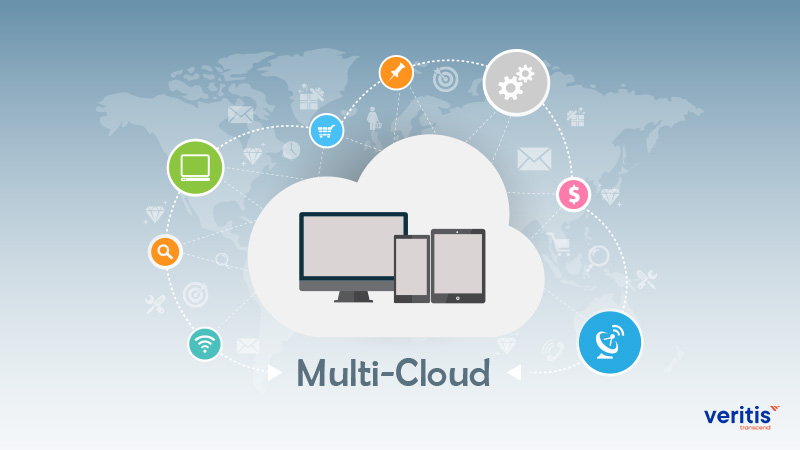
The widespread presence of cloud computing in today’s IT industry is leading to an increasing trend multi-cloud adoption among enterprises.
IDC, a market intelligence firm, estimates that over three-fifths of organizations across the world will adopt multi-cloud architecture by next year.
According to the 2022 State of Cloud Strategy Survey report, 90% of respondents say that multi-cloud is guiding their companies in achieving their business objectives. However, more work has to be done.
Due to evolving technology and expanding complexity, more firms are moving their workloads to multi-cloud deployment.
Although over the past few years companies have increasingly embraced multi cloud strategies, some even going as far as dedicating a cloud to run a single app. Suppose we have grown accustomed to discussing the cloud in terms of private and public clouds or even hybrid cloud strategies.
Consult our Cloud Consulting Expert
What is Multi Cloud?
Multi cloud is the principle of using more than one cloud platform in your cloud strategy. It is only an approach, not a particular technology. A multi cloud platform refers to using many clouds or the best cloud service providers.
To maximize the advantages of each specific service, businesses that do not want to rely on a single cloud vendor can leverage resources from several various providers.
A combination of the Infrastructure as a Service (IaaS), Platform as a Service (PaaS), and Software as a Service (SaaS) paradigms is known as a multi cloud platform solution. It also refers to utilizing various private and public cloud technologies. In general, IT pros use the term to designate a strategy that uses numerous public cloud services.
What is a Multi Cloud Strategy?

The goal and execution of multi cloud is a multi cloud strategy. Therefore, it is actively choosing to be in the multi cloud platform, not by default.
For instance, many businesses initially adopt the cloud slowly, one minor service or application at a time. It quickly gets out of control, and you have to clean up your cloud sprawl. There must be a plan. We’ll demonstrate that developing a multi cloud strategy requires considering your needs and the vendors who best meet them. For instance, the distinction between homogeneous and heterogeneous clouds might be relevant:
We’ll demonstrate that developing a multi cloud strategy requires considering your needs and the vendors who best meet them. For instance, the distinction between homogeneous and heterogeneous clouds might be relevant:
- Several different clouds from different vendors may be included in a homogeneous cloud.
- Contrarily, a heterogeneous cloud might refer to three publicly accessible clouds from different vendors.
Why do Companies Implement Multi Cloud Strategy?
Companies employ multi cloud deployment for different reasons. Some business executives wish to reduce financial risk by avoiding reliance on a single cloud provider. Adopting a responsive strategy may be challenging for a business if it is forced to work with more than one vendor. Others choose a multi cloud solution to reduce the chance of a localized hardware failure. An incident like this at a local data centre may take the entire business offline. Significantly lowering the danger of catastrophic failure is multi cloud platform.
Multi cloud solutions can also be a powerful tool in the fight against shadow IT or employee-used apps that are not authorized but are nonetheless under IT management. A multi cloud environment can be helpful in this situation because it enables users to take advantage of their preferred cloud transformation technologies while still adhering to security regulations. This issue typically arises when IT policies fail to meet an enterprise’s needs.
IT stakeholders can manage a multi-cloud deployment using the tools provided by the best cloud service providers. A multi cloud platform management platform can also be used to reduce complexity. Because each business’s use cases will differ, there is no single best practice manual for managing multiple clouds.
Why Choose a Multi Cloud Strategy?

A multi-cloud strategy enables businesses to meet internal and external customer needs.
It is a decision that prioritizes the customer’s needs, ensures that client data is managed and stored locally in Europe, and is exempt from extraterritorial laws like the CLOUD Act.
Also, a solid option, Multi-AZ, Multi-Region, and Multi-Provider techniques enable businesses to develop robust, highly available services.
It is a growth-oriented decision because it enables companies to hire engineers based on adaptability rather than familiarity with particular cloud providers. Additionally, it guarantees the finest development experience imaginable.
Since adopting carbon-neutral data centres and having the opportunity to scale up or down as their business expands protects your company’s long-term existence, it is a sustainable decision.
Multi cloud environment is constantly expanding and changing, giving you access to new technology and capabilities. Particularly for new enterprises, the abundance of providers and the ongoing expansion might appear overwhelming and complicated. While each business has a unique multi cloud strategy that is tailored to meet their particular objectives and needs, there are best practices that apply to all businesses when implementing a multi cloud environment strategy.
Useful link: Cloud Migration and IT Infra Support to Multimedia Industry
Benefits of Multi Cloud
Combining the most significant features of two distinct best cloud service providers for your IT strategy can create countless possibilities and flexibility. Still not convinced by a multi cloud strategy? Consider the advantages that applying this kind of technique to your projects can have.
1) Low Latency and High-Speed Infrastructure
You can gain from a faster, low-latency infrastructure when your company expands its networks to numerous suppliers. This speeds up application response times and enhances the user experience for your clients. Only when there are private links between the two best cloud service providers is it possible to achieve this highly efficient connection.
2) Enhanced Resilience
You can trust that your private information will be well protected without any action because each cloud transformation provider you use is accountable for its data protection. However, it will be crucial to ensure that your vendors consistently evaluate your network’s security, particularly as your infrastructure and software evolve over time.
3) More Effective Risk Management
Nothing is worse than having your critical technological components fail when you need them. Thus it’s crucial to always have a risk management policy in place. In addition, selecting a multi cloud solution architecture gives your company an additional layer of security. You may immediately move to your alternate provider or back up everything to a private cloud to secure your applications and crucial data if one of the vendors you work with experiences infrastructure failure or is the target of a cyberattack.
4) Acquire Total Agility
Many traditional businesses are looking for a supplier they can rely on to take over these activities since they cannot independently manage multi-cloud security operations. You can achieve complete agility and task mobility by bringing in a team with relevant experience.
5) Research Vendors
To avoid switching vendors, later on, any vendor you choose must have the same values as your business, including how their vision for their product aligns with your cloud strategy.
You’ll have a few more things to consider in addition to making sure the essential issues are high on the list for the vendor you select. This includes financial background information about the vendor’s market share, financial strength, and ecosystem of partners, all of which can help you determine how trustworthy and dependable they are.
Useful link: Cloud: The Technology Reinventing the Global Work Culture
Factors Influencing Spending on Multi-Cloud

The growing reliance on multi cloud security environments is prompting IT decision-makers across companies to reexamine their cloud transformation strategies. Cost optimization is the primary factor that influences an organization’s cloud spending. However, two-fifths of IT leaders are unaware of their companies’ spending on the cloud.
A recent global survey found that 45% of the respondents consider cost optimization as the prime reason for utilizing services from multiple cloud providers. Along similar lines, 44% of the respondents are driven by the need to maintain agility in their organizations, while 40% are in favor of risk mitigation.
Enterprise Solutions leader Bill Berutti says, “Multi-cloud has truly changed the game: The traditional way of looking at IT infrastructure simply does not work anymore. IT leaders must consider new ways to manage multi cloud environments to ensure they are getting the expected benefits from the public cloud, in terms of cost savings, automated performance optimization, and increased security and governance.”
Alleviating the Challenges
Implementation of security and governance policies, automation, cloud consumption costs, and resource utilization optimization are the major challenges associated with the management of multi cloud native apps. With distributed and virtual infrastructure 0n demand, security remains the focal point of investment for IT decision-makers over the next 2-3 years.
Organizations can move towards the successful management of their multi cloud security environments by taking stock of their cloud native apps assets and gaining a clear picture of their cloud costs.
In order to reduce the complexity created by multi cloud platforms, experts advise IT leaders to adapt their management approach through new technology solutions that leverage AI and machine learning.
The Way Forward
Tools for managing the cloud that can be used to monitor usage, efficiency, and costs in a multi-cloud environment. Additionally, they may provide intelligence and automation to your multi cloud infrastructure, allowing your business to use many clouds effortlessly and affordably without changing any of its operating systems or apps.
Multi cloud platform is now offering a significant competitive edge to many businesses. The bottom line is that organizations are gaining better performance and more cost-effectiveness by choosing a choice of cloud platforms and technologies suited to their requirements.
Veritis, the Stevie Award Winner, should be enlisted to provide you with personalized cloud solutions appropriate for your business. Approach us to have a customized cloud solution that satisfies your requirements.
Please contact Veritis at connect@veritis.com for more insights and responses to queries on Cloud Strategies.
Got Questions? Schedule A Call
Also Read: